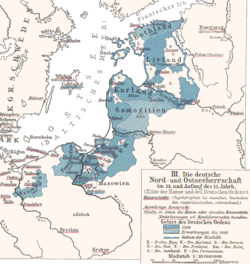Teutonic State
| State of the Teutonic Order | ||||||||||||
|
Staat des Deutschen Ordens (German) Civitas Ordinis Theutonici (Latin) |
||||||||||||
|
Fief of the Kingdom of Poland (1466–1525) |
||||||||||||
|
||||||||||||
|
The State of the Teutonic Order in 1410
|
||||||||||||
| Capital |
Marienburg (1308–1454) Königsberg (1454–1525) |
|||||||||||
| Languages | Low German, Latin, Baltic | |||||||||||
| Religion | Roman Catholic | |||||||||||
| Government | Theocratic Order | |||||||||||
| Grand Master | ||||||||||||
| • | 1230–1239 | Hermann (first) | ||||||||||
| • | 1510–1525 | Albert (last) | ||||||||||
| Legislature | Estates | |||||||||||
| Historical era | Middle Ages | |||||||||||
| • | Treaty of Kruschwitz | 16 May 1230 | ||||||||||
| • | Polish–Teutonic War | 1326–1332 | ||||||||||
| • | Battle of Grunwald | 15 July 1410 | ||||||||||
| • | Polish–Teutonic War | 1519–1521 | ||||||||||
| • | Treaty of Kraków | 8 April 1525 | ||||||||||
| • | Prussian Homage | 10 April 1525 | ||||||||||
| Currency | Mark | |||||||||||
|
||||||||||||
| Today part of | ||||||||||||
|
History of Brandenburg and Prussia |
|||
|
Northern March pre–12th century |
Old Prussians pre–13th century |
||
|
Margraviate of Brandenburg 1157–1618 (1806) |
Teutonic Order 1224–1525 |
||
|
Duchy of Prussia 1525–1618 |
Royal (Polish) Prussia 1466–1772 |
||
|
Brandenburg-Prussia 1618–1701 |
|||
|
Kingdom in Prussia 1701–1772 |
|||
|
Kingdom of Prussia 1772–1918 |
|||
|
Free State of Prussia 1918–1947 |
Klaipėda Region (Lithuania) 1920–1939 / 1945–present |
||
|
Brandenburg (Germany) 1947–1952 / 1990–present |
Recovered Territories (Poland) 1918/1945–present |
Kaliningrad Oblast (Russia) 1945–present |
|
The State of the Teutonic Order (German: Staat des Deutschen Ordens; Latin: Civitas Ordinis Theutonici), also called Deutschordensstaat (pronounced [ˈdɔʏtʃ ɔɐdənsˌʃtaːt]) or Ordensstaat (pronounced [ˈɔɐdənsˌʃtaːt]) in German, was a crusader state formed by the Teutonic Knights or Teutonic Order during the 13th century Northern Crusades along the Baltic Sea. The state was based in Prussia after the Order's conquest of the Pagan Old Prussians which began in 1230. It expanded to include at various times Courland, Gotland, Livonia, Neumark, Pomerelia and Samogitia. Its territory was in the modern countries of Estonia, Latvia, Lithuania, Poland, and Russia. Most of the territory was conquered by military orders, after which German colonization occurred to varying effect.
...
Wikipedia





